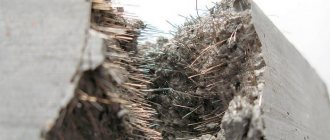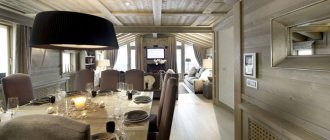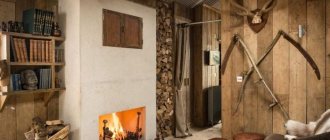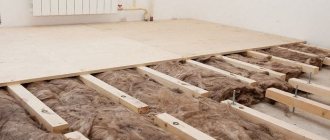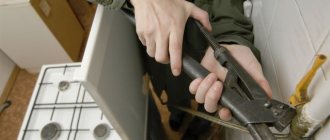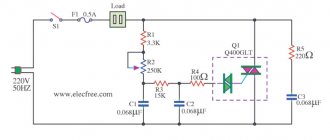→ Materials
In the bathroom, not only the bath itself is exposed to moisture. The floor, walls and ceiling are moistened to maximum levels during water procedures, so the base of the room structures must be constructed from water-repellent materials. The Knauf company offered a new product - “Aquapanel Internal”. What is she?
Essentially, it is a cement board with a fiberglass reinforcing layer inside. During its production, plasticizers are added to the solution, which increase the moisture-repellent properties of the product.
What it is?
Before getting acquainted with all the parameters and operational characteristics of aquapanels, it makes sense to understand what they are. This is a completely new sheet material that has become widely used in the construction industry. Such sheets have planes and end edges that are reinforced.
To achieve high strength parameters, these areas are reinforced with special mesh-type fiberglass. In the middle of the aqua panels there is a special core. It is made on the basis of lightweight concrete. High-quality cement slabs are characterized by ideal geometric parameters, making it very convenient to work with them without encountering unnecessary difficulties.
The very name of aquapanels indicates that they are characterized by a high level of resistance to moisture. That is why the materials in question are not afraid of high humidity levels or temperature changes. Aquapanels do not swell, even if they are completely immersed in water. The composition of these products does not include components of organic origin, so they are not at all susceptible to rotting.
In addition, aqua panels do not contain such an element as asbestos, so they are absolutely safe for the health of living organisms.
What are aquapanels made of and what does it give?
Aquapanels consist of Portland cement and porous mineral filler. The slabs are reinforced on both sides with fiberglass mesh. The edges are additionally reinforced with fiberglass; this coating helps protect the edges from impacts. This material structure provides certain advantages.
Aquapanel structure: core made of cement and mineral additives, fiberglass mesh coating
- Moisture resistance - the components of aqua panels are not afraid of high humidity, so they can be used in wet rooms: bathrooms, hammams, saunas, baths, showers and near swimming pools.
- Biological stability - the material does not contribute to the spread of mold, since Portland cement and mineral filler are not a favorable environment for the proliferation of fungal microorganisms.
- Fire resistance – the panels belong to the non-combustible (NG) class, which allows them to be used in rooms with increased fire safety requirements without additional surface and chemical fire protection.
Fire protection of certain materials, such as wood, involves the application of special fire-resistant chemical compounds (fire retardants). In the case of aqua panels, such additional processing is not required.
- Flexibility - the fiberglass mesh that covers the planes of the panels allows the material to bend in different directions, while maintaining strength. The bend can have a meter radius. These properties of the material are used in finishing work to create unusual shapes in the interior. Aquapanels allow you to create monolithic seamless coatings.
When bending, small cracks may appear on the surface of the material. This is not a defect or damage: the strength of the panels is maintained. And the cracks are closed at the finishing stage.
- Resistance to temperature changes - the material does not deteriorate and maintains geometry stability under temperature changes of up to 70 degrees. This property is useful when finishing saunas, baths and hammams.
Resistance to moisture and temperature changes allows you to use the aquapanel in the bathroom
- Compatible with any finishing method - aqua panels are suitable for any finishing process. It goes well with painting, plastering, puttying, painting, laying tiles, etc. At the same time, the panels do not crumble and do not produce defects that could damage the finishing coating.
- Ease of use – installation of panels is carried out using the “dry” installation method, which greatly simplifies this procedure for non-professionals.
The panels are available in widths of 900 and 1200 mm and lengths of 1200 - 3000 mm, the thickness of the sheets varies depending on the task: 12.5 mm are used for wall cladding, 8 mm for ceilings, 6 mm for creating coverings for tiles.
Flaws
In comparison with materials similar in their concept of application, such as plasterboard sheets, aquapanels have practically no disadvantages. The only thing, perhaps, is their cost. However, here too it is necessary to understand that the use of such products in moisture-resistant rooms can save on additional protection of walls from moisture. So the high cost will manifest itself more in those areas of work where the technical characteristics of this finishing material are not critical. Then you can really save money and use the same plasterboards.
The disadvantages also include the fact that the material is relatively new, so few professionals and everyone else have experience working with it for a long time. It is possible that such panels hide shortcomings that we do not yet know about. However, the first reviews from specialists are filled with positivity.
Varieties
It should be taken into account that aqua panels are divided into several different types. Each category of such building materials is intended for a specific operating framework and has its own characteristics and characteristics. Let's look at the differences between different types of modern high-quality aqua panels.
Domestic
For interior work, aqua panels are most often used, the thickness of which is only 6 mm. Similar products can be found in the assortment of large companies specializing in the production of building materials.
The specimens in question are lightweight, but at the same time they are quite durable and reliable . They are easy to install without requiring any extra effort. The service life of internal aqua panels is quite long. On sale you can find high-quality Knauf aqua panels, the thickness of which reaches 8 mm.
Such internal slabs are ideal for decorating a kitchen, balcony or bathroom. These products do not deteriorate from exposure to high humidity levels, do not deform, and do not change their original shape from liquid spilled on them. The dimensions of these products are in many ways similar to plasterboard boards, but their quality characteristics are much more practical.
The small mass of internal aqua panels allows them to be used even to decorate the ceiling base. If you line the walls with this material, you will be able to achieve almost ideal surfaces, ready for further finishing manipulations.
The slabs in question can be painted and various finishing materials can be fixed to them.
External
Aquapanels are often used for finishing frame and monolithic buildings, as well as garages and even country houses. The properties of the building material in question make it possible to create different architectural structures with it. The plates are flexible and very durable, so they are not afraid of mechanical stress.
External panels are perfect for cladding ventilated façade structures. They can be used as a basis for subsequent fastening of clinker or ceramic tiles. Other finishing materials for external work are also allowed to be used.
Universal
Today you can find on sale not only indoor and outdoor models of aquapanels, but also their universal versions. Such varieties are also available in the assortment of the famous Knauf brand. These types of building materials are characterized by multifunctionality. They fully justify their name. Universal slabs are suitable for both external and internal work.
The types of aqua panels under consideration can be used in conditions of temperature fluctuations and humidity levels. In addition, universal slabs are often used for the construction and installation of decorative walls and partitions.
Features of the use of aqua panels in construction
The multilayer structure provides the slabs with strength; they can bend without cracks thanks to the fiberglass. The core is formed from expanded clay sand, Portland cement, and a type of perlite. Includes hydrophobic modifiers, plasticizers and other additives.
The material is produced on a conveyor, where a continuous strip of concrete of the required thickness is formed. A coating of liquid cement mortar and a fiberglass mesh are applied to the surface. The mass hardens, then it is divided into individual elements. The surface of the slabs is smooth on the face, but the back side is characterized by roughness. The product is light gray in color.
The role of structural layers in the composition of slabs:
the mineral layer plays the role of insulation and provides rigidity to the product; fiberglass fabric prevents the appearance of cracks when finishing arched structures and prevents the front cement shell from crumbling; The cement layer on the surface ensures the moisture-resistant qualities of the panel and creates a surface impenetrable to water. Sheets are sheathed not only on ceilings, but also on walls in wet rooms, for example, in bathhouses or swimming pools. The material is installed like plasterboard on a frame made of galvanized metal profiles. They are secured to the sheathing with special self-tapping screws for such panels or fixed with adhesives.
Scope of application of moisture-resistant aquaplates:
cladding of external walls of houses, plinths and pedestals of buildings; filling between elements of frame buildings; for interior decoration of walls, ceilings, arched openings, vaults with a curvature radius of more than 1 meter; covering areas in engineering penetrations and mines; installation as an outer layer in fireplaces and stoves of various designs; installation of false walls, partitions, finishing of niches; surface treatment in garages, basements, storage rooms, cellars; in the form of a base for soft tiles, roofing felt; during the construction of car washes and service stations.
Kinds
Aquapanel has several types:
- External – for the construction of frame houses, cladding of external walls, facades, soffits.
- Internal – for renovations in showers, sinks, kitchens, laundries, garages, basements, areas around swimming pools or with daily wet cleaning. This article will talk mainly about it.
- Skylight – for cladding moisture-resistant suspended ceilings.
- Tile subfloor - for laying tiles or natural stone on a wooden floor. The thickness of the plate is only 6 mm.
Examples of using
Difference between panels for interior and exterior decoration
External panels operate under conditions of constant exposure to adverse atmospheric factors. They are affected by atmospheric chemistry in the form of alkalis, acids, and solar ultraviolet radiation. The plinth panels are close to the ground, so they are covered with snow, drops of automobile oils and particles of exhaust fall on the surface. In addition, the walls are subject to kicks.
Facade products must firmly resist the above factors. When installed as a curtain wall, it is possible to install insulation and waterproofing
The internal slabs are not exposed to the sun, so they do not contain ultraviolet catchers. But such products must withstand internal vapors and high humidity, so hydrophobic additives are added to the composition.
How to make a choice
Choosing the best material to decorate a room and disguise pipes and other flaws in the house is difficult. It is important to consider the following points:
- integrity of the packaging - in case of damage, it is better to refuse the product, because the sheets may be damaged;
- absence of arcuate protrusions;
- belonging to one party. Products from different batches may differ in shades, which will complicate the design of the bathroom;
- color - light glossy sheets will help to visually increase the area of a small room;
- quantity - it is necessary to provide for the possibility of replacing sheets damaged during installation;
- the size of the canvases should optimally correspond to the size of the room so that less waste remains after installation;
- the density of the joining of panels - the absence of noticeable gaps if the panels are seamless.
To make the best choice, you must first decide on the type of facing material: tiles, glass, MDF, laminated sheets, mosaic, false or aquapanel. It is important to determine the purpose and area of installation, and in addition to select the optimal size of the canvas. You need to pay attention to color design to create a unified design throughout the entire house. For longer operation of the product, it is worth contacting a specialist, because proper installation extends the service life of the finish.
How much do cement slabs of aquapanels cost?
The larger the retail chain and the city in which it is located, the cheaper the aquapanel is - this is a fact.
Unfortunately, this modern building material is still not easy to find in retail outlets in small settlements
If we talk about the cost of products, then in the fall of 2021 the situation is as follows: universal Knauf aquapanels can be bought on average for 410-580 rubles per sheet, depending on the thickness; price of external Knauf aquapanels – 710 rubles; price of Knauf internal water panels – 760 rubles; lightweight for ceilings - 690 rubles.
Follow the latest innovations in the production of building materials, because they help to significantly reduce costs and at the same time get a decent result! If you have already used aquapanels and can share your impressions of their use, write about it in the comments!
The material can withstand up to 75 courses of freezing and thawing without breaking and lasts for about fifty years.
During installation, the significant heaviness of the finishing layer is taken into account - the weight of each square is on average 10 - 15 kg.
The better to glue
To seal seams during installation, you will need special glue. The composition usually used here is AQUAPANEL KNAUF . The structure is a one-component polyurethane-based adhesive, which is available in 310 ml .
The composition is completely ready for use. Stated consumption: 25 ml/1 meter of seam . Accordingly, the tube is enough for 6.5 m2 of the treated surface.
Work is carried out only at positive temperatures, drying time is approximately 40 minutes .
After application, the glue increases the reliability of the structure and eliminates the need for puttying, which significantly reduces the work process.
Mounting methods
Aquapanels are mounted on a frame made of wood or metal profile. This method of installing a rough coating has a number of advantages.
- You can hide communications (water pipes, electrical wiring, etc.) under the sheathing. The coating will protect these important elements from damage and also hide them from the interior of the room.
- Lathing allows you to insulate and provide sound insulation to external or internal walls. To do this, heat-insulating material (mineral wool, polystyrene foam, etc.) is laid between the racks.
- Installation on the lathing allows you to level the base; for example, it can be used to hide defects in the brickwork.
The sheathing can be made of wood or metal profile
- Wooden sheathing - constructed using bars, the moisture content of the material should not exceed 20%. Also, when used in a damp room, wood must be treated with antiseptics, and if it is planned to increase its fire-resistant properties, then also with fire retardants.
Wooden lathing for aqua panels
When creating wooden lathing, you should use only coniferous species, as they have greater moisture resistance.
- A metal profile is the most common base for installing aqua panels. The profile lathing does not shrink, and it is not affected by room humidity. It is more durable and does not require additional chemical treatment.
Metal lathing for aquapanel
Installation nuances
Before installing purchased aqua panels, you must first prepare all the necessary tools. You should stock up on:
- pointed screws;
- high-quality self-tapping screws with an end for drilling;
- special reinforcing solution (glue);
- white putty.
Let's consider the main stages of proper installation of modern aqua panels.
- The first step is to clean the base on which the waterproof panels will be attached. It is required to remove absolutely all contaminants that are on the surface with utmost care.
- This is followed by the mandatory measurement of the working area, as well as the identification of lines (vertical and horizontal). In the area of the planned location of the waterproof profile, you will need to apply precise markings.
- At the next stage, you will need to mount and securely fasten the guide profile. This component acts as the basis for all other necessary components. You will first need to place a special sealing tape on the part to ensure better adhesion to surfaces.
- Further, based on the areas where the main parts are located, you may encounter some nuances. The lathing is installed in accordance with the same technology as in the case of using plasterboard sheets.
- When the fastening of the frame base is left behind, you can safely proceed to the installation of the aqua panels themselves. If the size of these building materials needs to be adjusted, they can be easily cut using a special construction knife. It happens like this: the fiber is cut through, as well as the internal filling, after which the slab simply breaks. On the other side of the sheet, similar manipulations are performed with respect to the reinforcing mesh.
- If we are talking about cladding wall structures, then all the main work needs to start from the bottom . The slabs must be laid carefully, not forgetting about the offset by one profile rack. This is necessary to prevent the appearance of cross-shaped joints.
- Using a conventional screwdriver, the materials in question can be easily fixed to the surface of the base.
- After this, you can proceed to applying and fixing the selected finishing materials . It is imperative to scrupulously seal all seams and joints on structures.
- It is strongly recommended to carefully hide absolutely all fasteners that are still visible after proper installation of the aquapanels.
- The solution must be carefully laid on corner surfaces. After this, these bases are covered with a reinforcing corner profile.
When dealing with the correct installation of the slabs in question, it is very important to remember that there must be a distance of at least 5 cm between the cement panels themselves and the ceiling base. The gap from the floor and floor coverings is also important - it must be at least 20 mm.
A special polyurethane adhesive solution must be applied to the edges of fixed products, which provides a more reliable and high-quality fastening.
How to install products
Before you begin installing cement panels, you need to prepare tools and materials for the job. An aquapanel is a product that does not require too much effort to be placed on the surface. It is enough to use self-tapping screws, glue and putty. The manufacturer Knauf produces products that are specifically designed for these sheets and are ideal for installation:
- Pointed screws, as well as self-tapping screws with a drilling end. The choice of variety depends on the base on which the slab is installed.
- Adhesive reinforcing solution.
- White putty.
Aquapanels on the house Source stroynet.ru
